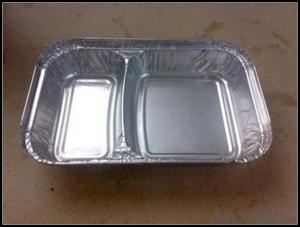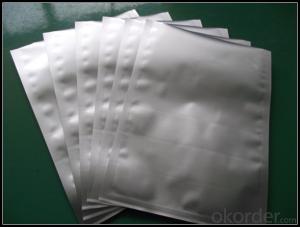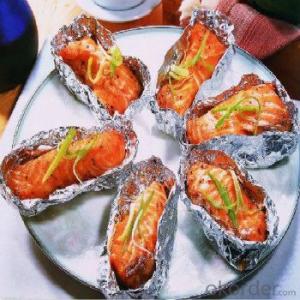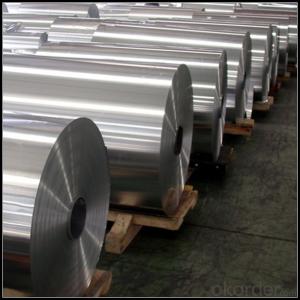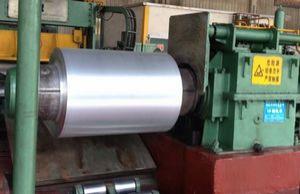Aluminum Coil Price:AA8011/AA1235 Aluminum Foil for Food Packaging/Container
- Loading Port:
- Dalian
- Payment Terms:
- TT OR LC
- Min Order Qty:
- 5 m.t.
- Supply Capability:
- 2000 m.t./month
OKorder Service Pledge
OKorder Financial Service
You Might Also Like
Specification
1. Specification of Aluminum Foil
Thickness | 0.005mm-0.2mm |
Popular Thickness | 0.01mm/0.02mm/0.025mm/0.03mm/0.006mm/0.008mm |
Width | 20mm-2500mm |
inner diameter | 76mm / 152mm |
Material | AA1050, AA1060, AA1070, AA1100, AA1235, AA3003, AA3004, AA3005, AA3104, AA3105, AA5052, AA5005, AA5754, AA5083, AA8011, AA8006,AA8079, etc |
Temper | O,H12,H14,H16,H18,H22,H24,H26, H28, H32,H34,H36,H38 and so on |
Surface | Mill finish / Coated/ Embossed |
Packing | Export standard wooden pallets |
Payment Terms | 100% irrevocable L/C at sight or 30% T/T in advance as deposit,70% balance against the B/L copy |
Minimum Order Quantity | 5MT |
Delivery time | 30-35 days after the receiving L/C or deposit |
2. Applications of Aluminum Foil
(1) Interior: wall cladding, ceilings, bathrooms, kitchens and balconies, shutters, doors, windows,
(2) Exterior: wall cladding, facades, roofing, canopies, tunnels,column covers , renovations.
(3).Advertisement: display platforms, signboards, fascia, shop fronts.
3. Features of Aluminum Foil
*Such coil is specially designed to replace aluminum ingot, due to the high export tax of aluminum ingot, the coil has better price than ingot.
*This type of coil can fit customer's remelting furnace just like ingot, no need to make any change to the production line that was previously used for ingot. The standard coil size and weight is very suitable for the feed gate of furnace.
*This type of coil causes less material wastage than ingot when remelted.
*Our coil is made directly from ore, no need to go though the ingot making process, quality is much better than other suppliers who use ingot scrap to make coil.
Be free from Oil Stain, Dent, Inclusion, Scratches, Stain, Oxide Dicoloration, Breaks, Corrosion, Roll Marks, Dirt Streaks and other defect which will interfere with use
4. Certificates:
SGS and ROHS (if clients request, paid by client), MTC (plant provided), Certificate of Origin (FORM A, FORM E, CO), Bureau Veritas (if client request, paid by client), CIQS certificate and so on.
5. Images of Aluminum Foil
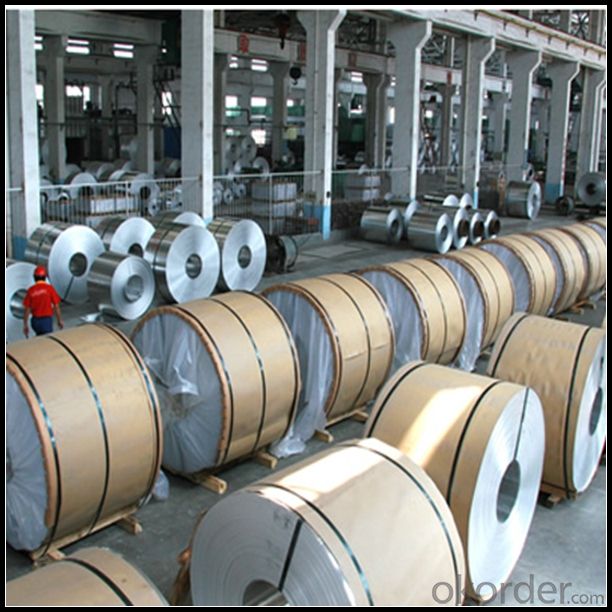

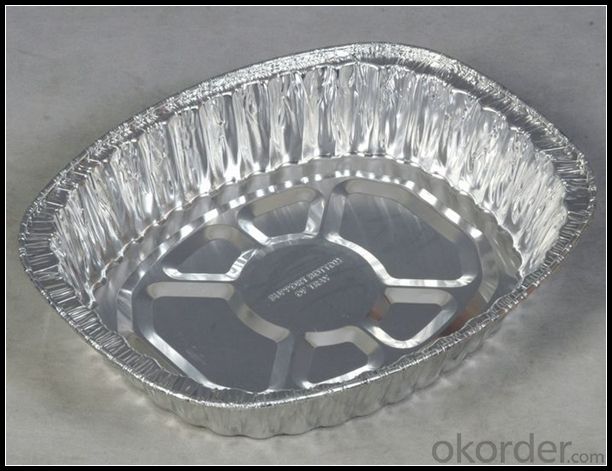
6. About Us
CNBM Group is short for China National Building Materials Group Corporation, which is established in 1984 with approval from the State Council
CNBM Group is the largest comprehensive building materials industry group in China
The Group has a total asset of over RMB 360 billion, more than 180,000 employees and 17 subsidiaries
CNBM International Corp., establishedin 2004, is the business entity for trade and logistic of CNBM Group.
CNBM International is highly recognizedby its business partners and clients all over the world and has establishedgood business relationship with the customers in over 160 countries and regionsall over the
world.
7. FAQ
1) What is the delivery time?
Depends on actual order, around 30 to 35 days
2) What is the QC system?
We have QC staff of 30 persons and advanced equipment, each production is with MTC traced from Aluminum ingot lot.
3) What market do you mainly sell to?
Australia, America, Asia, Middle East, Western Europe, Africa etc
- Q: a) Although Aluminium is a reactive metal, it is used to make door frames and window frames.b) Although Aluminium conducts heat, it is used to make blankets, which are good thermal insulators.
- aluminum is cheap . easy to work with and good looking , because of this it is used to make door frames etc.
- Q: Can a digital caliper be utilized to accurately measure the diameter of an aluminum coil?
- <p>Yes, you can use a digital caliper to measure the diameter of an aluminum coil accurately. Digital calipers are precise measuring tools, often accurate to 0.001 inches or 0.02mm, which is suitable for measuring the diameter of various objects, including aluminum coils. Ensure the caliper is zeroed before use and that the coil's surface is clean and flat where the measurement is taken to get accurate readings.</p>
- Q: What kind of sensor is appropriate for aluminum coil thickness measurement?
- Use two sensors of ZLDS10X series to make a thickness gauge
- Q: What are the potential health risks associated with working with aluminum coils?
- Individuals who work with aluminum coils may face certain health hazards. One of the main concerns is the possibility of being exposed to aluminum dust or fumes. Inhaling these particles can lead to respiratory problems like coughing, difficulty breathing, and symptoms similar to asthma. Prolonged or excessive exposure to aluminum dust can even result in a condition called aluminum pneumoconiosis, which causes lung scarring and impairs breathing. Moreover, aluminum is a substance that is toxic to the nervous system, and prolonged exposure to high levels of aluminum can lead to neurological disorders. Some studies have suggested a potential connection between aluminum exposure and conditions like Alzheimer's disease, although further research is needed to establish a definitive cause-and-effect relationship. Another health risk associated with working with aluminum coils is the possibility of skin irritation. Direct contact with aluminum can cause contact dermatitis, which manifests as redness, itching, and inflammation of the skin. To minimize the risk, it is crucial for workers to take necessary precautions such as wearing protective clothing and gloves. Additionally, working with aluminum coils may involve the use of chemicals like lubricants, solvents, or cleaners, which also pose health risks. These chemicals can cause skin and respiratory irritation, and in some cases, they may lead to long-term health issues such as organ damage or cancer. In conclusion, while there are many advantages to working with aluminum coils, it is vital to be aware of the potential health hazards involved. Employers and workers should take appropriate safety measures, including wearing personal protective equipment, implementing effective ventilation systems, and following best practices to minimize exposure and mitigate any potential health risks. Regular monitoring and medical check-ups are also advisable for individuals regularly exposed to aluminum coils to ensure early detection and prevention of any adverse health effects.
- Q: What does 1060 stand for in 1060 aluminum rolling?
- It means the aluminum content should be above 99.6%.
- Q: For the reaction at the anode:Al ----gt; Al3+ + 3eHowever, at the anode, oxygen are also produced and forms aluminium oxide(Al2O3) with aluminium.Are Oxygen produced by oxidation of water by electrolysis? or some reaction else?If Oxygen are produced by oxidation of water, then why it can be oxidise sinceAl ----gt; Al3+ + 3e E^0= + 1.66V2H2O ---gt; O2 + 4H+ + 4e E^0= - 1.23V(if refers to E null value) Oxygen should only be produced after all the Al have been finish oxidised.Both reaction happen at the same time? Is it possible?
- with respect to your massege, i must say that it depends of what electrode you choice for your work. but with refer to E i think oxidation of watter do not interference with oxidation of Al and only oxidation of Al happen .
- Q: What is the tensile strength of an average aluminum coil?
- The tensile strength of an average aluminum coil can vary depending on the specific alloy and manufacturing process used. However, commonly used aluminum alloys typically have a tensile strength ranging from 100 to 300 megapascals (MPa).
- Q: Aluminum silicate felt fiber needle blanket noise reduction?
- Aluminum silicate needled blanket belongs to the porous material, porosity higher than ninety-six percent in noise reduction has an absolute advantage, because the aluminum silicate needled blanket belongs to soft products, the lack of stress in the industrial application, so there is no large-scale promotion, mainly used in the silencing device of heavy trucks, trucks and cars. And in the heat insulation, aluminum silicate needled blanket technology with a special one-time plastic molding, as the car chassis fireproof heat insulation layer, and now Xiamen Kinglong has reached a cooperation agreement.
- Q: Are aluminum coils suitable for electrical conductivity applications?
- Yes, aluminum coils are suitable for electrical conductivity applications. Aluminum is known for its excellent electrical conductivity, second only to copper among common metals. It has approximately 61% of the conductivity of copper, making it a reliable choice for various electrical applications. Aluminum coils are commonly used in power transmission, transformers, and electrical motors due to their ability to efficiently conduct electricity. Additionally, aluminum coils are lightweight, which makes them easier to handle and install in electrical systems. However, it is important to note that aluminum has a higher resistance compared to copper, so larger aluminum conductors may be required to achieve the same electrical performance. Overall, aluminum coils are a suitable option for electrical conductivity applications.
- Q: Can aluminum coils be used in the production of heat sinks?
- Yes, aluminum coils can be used in the production of heat sinks. Aluminum is a popular material for heat sinks due to its excellent thermal conductivity and low cost. Heat sinks are used to dissipate heat from electronic components such as processors, power transistors, and LED lights. The coils can be manufactured into various shapes and sizes to meet specific heat dissipation requirements. Additionally, aluminum is lightweight, corrosion-resistant, and easily available, making it an ideal choice for heat sink production.
Send your message to us
Aluminum Coil Price:AA8011/AA1235 Aluminum Foil for Food Packaging/Container
- Loading Port:
- Dalian
- Payment Terms:
- TT OR LC
- Min Order Qty:
- 5 m.t.
- Supply Capability:
- 2000 m.t./month
OKorder Service Pledge
OKorder Financial Service
Similar products
Hot products
Hot Searches
Related keywords
